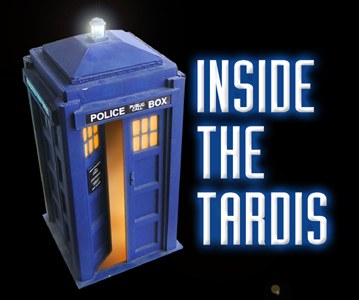

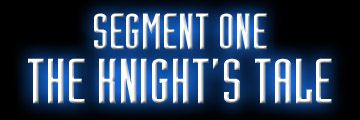
Not much action goes on in this episode. It is mostly a mental anguish problem.
A knight appears at a medieval abbey lamenting his failure in a quest, whose purpose is not at this time revealed to us. He pleads to his lady, the statue of Mary, to atone for his failure, to show him a sign that he is worthy of his burden when before you know it, along pops the TARDIS.
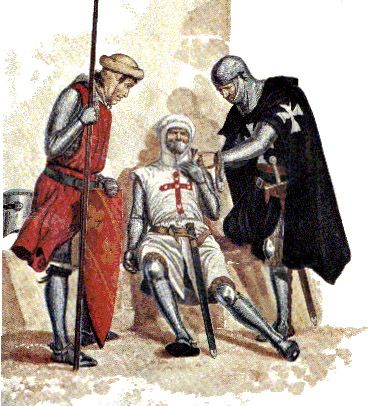
Even at this early stage, many people will come to the conclusion that the knight's quest was for the Holy Grail. But it matters not. If people assume that to be the case, that was fine by me. Nothing is lost by knowing or assuming that.
The main point of this story is the dilemma given to the Knight. He feels an obligation to protect his lady, the statue he himself prays to, and we assume, the statue at which he was praying when he was inspired to go on his original quest. On the other hand, allowing the Doctor to destroy the Madonna statue is part of the very quest she sent him on. And the Doctor's description of the White Guardian would be enough to convince a knight at that time that the Doctor was talking about God.
He relents, believing that God himself has asked for the statue, and that because of that, it must be sacrificed for the quest.
I take this opportunity to rant a bit about the 767AD meeting of Catholic clergy in which the second commandment was edited to remove any reference to graven images. At the time, Catholics loved their statues and icons. The problem was that here was Moses coming down from the hills with stone tablets in god's very own handwriting, (not even written by a human channeling god, but god's very own handwriting, in fire, upon these tablets) commanding that his people absolutely not worship before graven images. Hey, that's exactly what the Catholic Church is based on.
This concept of worshiping before graven images even caused a huge rift in the Church, causing the election of a second pope, and a split between the Roman Catholics and the Eastern Orthodox Catholics - all over icon worship.
So the Doctor casually brings up the editing of God's second commandment.
I have read some interesting arguments on this fact. And if you do a web search, you can find many Catholics arguing that there was no editing done - that it's was simply one valid interpretation. But the Catholic Bible simply erases about two lines of a commandment that Moses brought down to his people. A commandment written by god's own hand. And here, the Catholics have wiped two lines clean from the document. That isn't editing God's words???
Anyway, not to sound overly critical I had Sir Edmund counter the Doctor's accusation by having him say that the Doctor's complaint was only one interpretation. Which fit in nicely when Sir Edmund asks about the Guardian, whether or not he is god, and the Doctor says that that's one interpretation. Good parallel structure there.
I got an e-mail from one reader who complained that I was too preachy in this episode, too anti-Catholic, too anti-Religious. Well, it may have seemed that way at this stage, but as the episodes progress, and we finally read The Big Finish we can clearly see that this whole story is about religion and faith. It is not anti-religious to point out that the Catholics edited God's words to suit themselves - it is simply telling the truth.
For most stories I do I create a storyboard. The reason is that I need to know what the shots are going to look like and to ensure that they fit the story.
I began to do a storyboard for this one, and I did for the important parts. There were some shots I just had to get right. The TARDIS showing up while Sir Edmund is kneeling in penetence... but by the time I got to the part where it was just a series of two-shots with the Doctor and Sir Edmund talking, which really didn't need a storyboard so I just winged it.
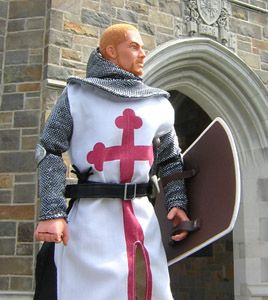
The newest companion, Sir Edmund of Sussex, is a modern-era Adventure Team GI Joe with flocked hair and beard. I thought the slim beard fit the character well, and while I am not usually a fan of this GI Joe headsculpt, with the flocked red hair he looked just right.
He is wearing the armor and tabard of the Monty Python and the Holy Grail figure, Sir Galahad. The figure itself was unsuitable, as the face was dead-gray and had a silly grin on its face. But the care and accuracy given to the outfit by its makers, Sideshow Toy, was exemplary, making this one of the finest costumes you'll see in this story.
The familiar red cross of the Templar Knights is fitting, I believe, as this knight's specific affiliations are not well-explored at this point.
And lest you believe Sir Edmund to be an unintelligent person, just because he lived during the Crusades, think again. There comes a moment in this tory where the Doctor condescends to the knight, and he will brook none of it. He explains that he knows he can't comprehend the TARDIS, but he understands that it works. I thought that was a great line and defined a major part of Sir Edmund's character.
The abbey Sir Edmund arrives at is actually the Norwood Town Hall in Norwood, MA. I was hoping for a nice, old church door to shoot in front of, and there are a few candidates within a 20 mile radius, but to organize a quick snatch-n-grab shoot that far away from home was too difficult, so I opted to shoot in front of the pristine Town Hall. But this is fitting. The other churches are quite old, and look it. I wanted to show the Abbey not long after it was built when the stone work would have been clean and crisp, not deteriorated in any way.
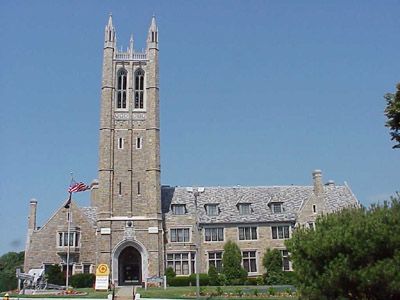
The date above the doorway was altered to read 1126, which is also appropriate for my story. It is edited by me to cover up the real construction date of this building.
The statue of Mary, however, is shot in a local park, nowhere near the Town Hall.
The other point to bring up here is the black sack that Edmund carries with him everywhere. At this point we have no idea what it is in it, but it obviously causes Edmund great stress. This sack will be seen on Edmund in every episode until the end, where if you play your cards right, you may discover what secrets Edmund is keeping from you this early in the story.
I did my research. The date of the Second Crusade is accurate. Called in 1145-48. In this story, it is 1156, some years later. The crusade in the east was a failure for the crusaders and a great victory for the Muslims. It would ultimately lead to the fall of Jerusalem and the Third Crusade at the end of the 12th century.
I also did research and found out about the Abbey of St. Julian the Hospitaler and it seemed ideal for the setting of my knight's return. Sticklers may find out that I have some dates wrong, or that a Knight Templar wouldn't be at the Abbey of St. Julian the Hospitaler, or other such anachronisms or thematic errors. To those sticklers I say "thanks for bringing that up. This is a science-fantasy story, not a retelling of history, though I do make attempts to tie it to real history."